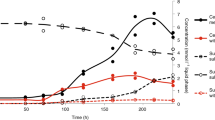Abstract
Sulphur-dependent archaebacteria, which are found around nearly boiling continental solfataric springs and mud holes, can be assigned to two distinct branches: the aerobic, sulphur-oxidizing Sulfolobales1–4 and the strictly anaerobic sulphur-reducing Thermoproteales5–7. Here, we report the isolation of a group of extremely thermophilic solfataric archaebacteria that are able to grow either strictly anaerobically by reduction, or fully aerobically by oxidation of molecular sulphur, depending on the oxygen supply. We have also established that the ability to grow in these two ways is shared by Sulfolobus brierleyi, a well-known less thermophilic sulphur-oxidizing archaebacterium capable of ore-leaching8. The phenomenon may be dependent on a fundamental switch in genome expression. These organisms might represent the primitive forerunners of sulphur-oxidizing archaebacteria, meeting their energy requirements either by oxidation or by reduction of the same element.
Similar content being viewed by others
References
Brock, T. D., Brock, K. M., Belley, R. T. & Weiss, R. L. Archs Microbiol. 84, 54–68 (1972).
Brierley, C. L. & Brierley, J. A. Can. J. Microbiol. 19, 183–188 (1973).
Zillig, W. et al. Archs Microbiol. 125, 259–269 (1980).
Woese, C. R., Gupta, R., Hahn, C. M., Zillig, W. & Tu, J. System appl. Microbiol. 5, 97–105 (1984).
Zillig, W. et al. Zbl. Bakt. Hyg., I. Abt. Orig. C2, 205–227 (1981).
Stetter, K. O. Nature 300, 258–260 (1982).
Fischer, F., Zillig, W., Stetter, K. O. & Schreiber, G. Nature 301, 511–513 (1983).
Brierley, C. L. CRC crit. Rev. Microbiol. 6, 207–262 (1978).
De Rosa, M., Gambacorta, A. & Bu'Lock, J. D. J. gen. Microbiol. 86, 156–164 (1975).
Balch, W. E., Fox, G. E., Magrum, L. J., Woese, C. R. & Wolfe, R. S. Microbiol. Rev. 43, 260–296 (1979).
Allen, M. B. Archs Microbiol. 32, 270–277 (1959).
Wildgruber, G. et al. Archs Microbiol. 132, 31–36 (1982).
Marmur, J. & Doty, P. J. molec. Biol. 5, 109–118 (1962).
Steigerwaldt, A. G., Fanning, G. R., Sise-Ashbury, M. A. & Brenner, B. J. Can. J. Microbiol. 22, 121–137 (1976).
Kessel, M. & Klink, F. Nature 287, 250–251 (1980).
Williams, W. J. Handbook of Anion Determination, 570–572 (Butterworths, London, 1979).
Laemmli, U. K. Nature 227, 680–685 (1970).
Burton, K. Biochem. J. 62, 315–322 (1956).
Gillespie, S. & Gillespie, D. Biochem. J. 125, 481–487 (1971).
Birnstiel, M. L., Sells, B. H. & Purdom, I. F. J. molec. Biol. 63, 21–39 (1972).
Kelly, R. B., CozzareIli, N. R., Deutscher, M. P., Lehman, J. R. & Kornberg, A. J. biol. Chem. 245, 39–45 (1979).
Author information
Authors and Affiliations
Rights and permissions
About this article
Cite this article
Segerer, A., Stetter, K. & Klink, F. Two contrary modes of chemolithotrophy in the same archaebacterium. Nature 313, 787–789 (1985). https://doi.org/10.1038/313787a0
Received:
Accepted:
Issue Date:
DOI: https://doi.org/10.1038/313787a0
- Springer Nature Limited
This article is cited by
-
Acidophilic bacteria and archaea: acid stable biocatalysts and their potential applications
Extremophiles (2012)
-
The self-organizing fractal theory as a universal discovery method: the phenomenon of life
Theoretical Biology and Medical Modelling (2011)
-
Heterologous Expression and Characterization of an Alcohol Dehydrogenase from the Archeon Thermoplasma acidophilum
Molecular Biotechnology (2009)





